Development of Wet Scavenging Process of Particles in Air Quality Modeling
Abstract
:1. Introduction
2. Methods
2.1. Theoretical Analysis of Wet Scavenging
2.2. Modification of the Wet Scavenging Algorithm in Chemical Transport Models (CTMs)
2.3. Chemical Transport Models (CTMs)
3. Results
3.1. Results of Simulation CTM
3.2. Comparison with Observational Data
4. Discussion
5. Conclusions
Author Contributions
Funding
Institutional Review Board Statement
Informed Consent Statement
Data Availability Statement
Acknowledgments
Conflicts of Interest
References
- Hales, J. Wet removal of sulfur compounds from the atmosphere. Atmos. Environ. 1978, 12, 389–399. [Google Scholar] [CrossRef]
- Tsai, W.T.; Altwicker, E.R.; Asman, W.A.H. Numerical simulation of wet scavenging of air pollutants—II. Modeling of rain composition at the ground. Atmos. Environ. Part A Gen. Top. 1990, 24, 2485–2498. [Google Scholar] [CrossRef]
- Kwon, H.S.; Ryu, M.H.; Carlsten, C. Ultrafine particles: Unique physicochemical properties relevant to health and disease. Exp. Mol. Med. 2020, 52, 318–328. [Google Scholar] [CrossRef]
- Schumann, T. Large discrepancies between theoretical and field-determined scavenging coefficients. J. Aerosol Sci. 1989, 20, 1159–1162. [Google Scholar] [CrossRef]
- Lin, C.; Huo, T.; Yang, F.; Wang, B.; Chen, Y.; Wang, H. Characteristics of Water-soluble Inorganic Ions in Aerosol and Precipitation and their Scavenging Ratios in an Urban Environment in Southwest China. Aerosol Air Qual. Res. 2021, 21, 200513. [Google Scholar] [CrossRef]
- Ma, C.; Sera, K. The Chemical Nature of Individual Size-Resolved Raindrops and Their Residual Particles Collected During High Atmospheric Loading for PM2.5. Asian J. Atmos. Environ. 2017, 11, 176–183. [Google Scholar] [CrossRef]
- Chate, D.M.; Murugavel, P.; Ali, K.; Singh, S.; Beig, G. Below-cloud rain scavenging of atmospheric aerosols for aerosol deposition models. Atmos. Res. 2011, 99, 528–536. [Google Scholar] [CrossRef]
- Slinn, W. Some approximations for the wet and dry removal of particles and gases from the atmosphere. Water Air Soil Pollut. 1977, 7, 513–543. [Google Scholar] [CrossRef]
- Levine, S.Z.; Schwartz, S.E. In-cloud and below-cloud scavenging of Nitric acid vapor. Atmos. Environ. 1982, 16, 1725–1734. [Google Scholar] [CrossRef]
- Volken, M.; Schumann, T. A Critical review of below-cloud aerosol scavenging results on Mt. Rigi. Water Air Soil Pollut. 1993, 68, 15–28. [Google Scholar] [CrossRef]
- Andronache, C. Estimated variability of below-cloud aerosol removal by rainfall for observed aerosol size distributions. Atmos. Chem. Phys. 2003, 3, 131–143. [Google Scholar] [CrossRef]
- Mircea, M.; Ştefan, S.; Fuzzi, S. Precipitation scavenging coefficient: Influence of measured aerosol and raindrop size distributions. Atmos. Environ. 2000, 34, 5169–5174. [Google Scholar] [CrossRef]
- McCully, C.R.; Fisher, M.; Langer, G.; Rosiński, J.; Glaess, H.; Werle, D. Scavenging Action of Rain on Air-borne Particulate Matter. Ind. Eng. Chem. 1956, 48, 1512–1516. [Google Scholar] [CrossRef]
- Zhao, S.; Yu, Y.; He, J.; Yin, D.; Wang, B. Below-cloud scavenging of aerosol particles by precipitation in a typical valley city, northwestern China. Atmos. Environ. 2015, 102, 70–78. [Google Scholar] [CrossRef]
- Xu, D.; Ge, B.; Wang, Z.; Sun, Y.; Chen, Y.; Ji, D.; Yang, T.; Ma, Z.; Cheng, N.; Hao, J.; et al. Below-cloud wet scavenging of soluble inorganic ions by rain in Beijing during the summer of 2014. Environ. Pollut. 2017, 230, 963–973. [Google Scholar] [CrossRef]
- Ma, S.; Chai, J.; Kai, W.; Xiang, Y.; Wan, Z.; Zhang, J. Experimental and model research on chloride ion gas–solid distribution in the process of desulfurization wastewater evaporation. RSC Adv. 2018, 8, 26283–26292. [Google Scholar]
- Oduber, F.; Calvo, A.I.; Blanco-Alegre, C.; Castro, A.; Alves, C.; Cerqueira, M.; Lucarelli, F.; Nava, S.; Calzolai, G.; Martin-Villacorta, J.; et al. Towards a model for aerosol removal by rain scavenging: The role of physical-chemical characteristics of raindrops. Water Res. 2021, 190, 116758. [Google Scholar] [CrossRef]
- García, E.; Díaz, J.J.D.C.; Ordóñez, C.; Taboada, J. A Mathematical Approach to Selective Scavenging of the Different Classes of Typical Atmospheric Aerosols by Rainout and Health Impact. Environ. Technol. 2006, 27, 337–348. [Google Scholar]
- Bae, S.Y.; Park, R.J.; Kim, Y.P.; Woo, J. Effects of below-cloud scavenging on the regional aerosol budget in East Asia. Atmos. Environ. 2012, 58, 14–22. [Google Scholar] [CrossRef]
- Kim, K.D.; Lee, S.; Kim, J.-J.; Lee, S.-H.; Lee, D.; Lee, J.-B.; Choi, J.-Y.; Kim, M.-J. Effect of Wet Deposition on Secondary Inorganic Aerosols Using an Urban-Scale Air Quality Model. Atmos. Environ. 2021, 12, 168. [Google Scholar] [CrossRef]
- Bi, C.; Isaacman-VanWertz, G. Estimated Timescales for Wet Deposition of Organic Compounds as a Function of Henry’s Law Constants. Environ. Sci. Atmos. 2022, 2, 1526–1533. [Google Scholar] [CrossRef]
- Shimadera, H.; Hayami, H.; Chatani, S.; Morino, Y.; Mori, Y.; Morikawa, T.; Yamaji, K.; Ohara, T. Sensitivity analyses of factors influencing CMAQ performance for fine particulate nitrate. J. Air Waste Manag. Assoc. 2014, 64, 374–387. [Google Scholar] [CrossRef] [PubMed]
- Wan, H.; Zhang, K.; Vogl, C.J.; Woodward, C.S.; Easter, R.C.; Rasch, P.J.; Feng, Y.; Wang, H. Numerical coupling of aerosol emissions, dry removal, and turbulent mixing in the E3SM Atmosphere Model version 1 (EAMv1), part I: Dust budget analyses and the impacts of a revised coupling scheme. Geosci. Model Dev. 2024, 17, 1387–1407. [Google Scholar] [CrossRef]
- Hales, J. Wet Removal of Pollutants from Gaussian Plumes: Basic Linear Equations and Computational Approaches. J. Appl. Meteorol. Climatol. 2002, 41, 905–918. [Google Scholar] [CrossRef]
- Song, Z.; Bai, X. The Impact of Convective Transport and Wet Deposition of Airborne Dust Particles on the Numerical Simulation of Northeast Asian Storms. In Proceedings of the 2006 IEEE International Symposium on Geoscience and Remote Sensing, Denver, CO, USA, 31 July–4 August 2006. [Google Scholar]
- Park, D.; Choi, Y.; Sunwoo, Y.; Jung, C. A Study on the Wet Scavenging Characteristics of Atmospheric Aerosol in the Korean Peninsula Using NAMIS (National Ambient Air Quality Monitoring Information System) Data and Its Application to Air Quality Modeling System. Korean Soc. Atmos. Environ. 2023, 39, 437–447. [Google Scholar] [CrossRef]
- Nieto, P.G.; García, B.; Dı, J.; Braña, M.R. Parametric study of selective removal of atmospheric aerosol by below-cloud scavenging. Atmos. Environ. 1994, 28, 2335–2342. [Google Scholar] [CrossRef]
- Tsai, W.T.; Altwicker, E.R. Numerical simulation of wet scavenging of air pollutants—I. Modeling of sequential precipitation rates at the ground. Atmos. Environ. Part A Gen. Top. 1990, 24, 2473–2483. [Google Scholar] [CrossRef]
- Yalamov, Y.I.; Vasiljeva, L.; Schukin, E. The study of various mechanisms of in-cloud scavenging of large, moderately large, and small aerosol particles. J. Colloid Interface Sci. 1977, 62, 503–508. [Google Scholar] [CrossRef]
- Pruppacher, H.R.; Jaenicke, R. The processing of water vapor and aerosols by atmospheric clouds, a global estimate. Atmos. Res. 1995, 38, 283–295. [Google Scholar] [CrossRef]
- Mircea, M.; Ştefan, S. A theoretical study of the microphysical parameterization of the scavenging coefficient as a function of precipitation type and rate. Atmos. Environ. 1998, 32, 2931–2938. [Google Scholar] [CrossRef]
- Shukla, J.; Misra, A.; Sundar, S.; Naresh, R. Effect of rain on removal of a gaseous pollutant and two different particulate matters from the atmosphere of a city. Math. Comput. Model. 2008, 48, 832–844. [Google Scholar] [CrossRef]
- Naresh, R.; Sundar, S.; Shukla, J. Modeling the removal of gaseous pollutants and particulate matters from the atmosphere of a city. Nonlinear Anal. Real World Appl. 2007, 8, 337–344. [Google Scholar] [CrossRef]
- Berthet, S.; Leriche, M.; Pinty, J.; Cuesta, J.; Pigeon, G. Scavenging of aerosol particles by rain in a cloud resolving model. Atmos. Res. 2010, 96, 325–336. [Google Scholar] [CrossRef]
- Wang, X.; Zhang, L.; Moran, M.D. Bulk or modal parameterizations for below-cloud scavenging of fine, coarse, and giant particles by both rain and snow. J. Adv. Model. Earth Syst. 2014, 6, 1301–1310. [Google Scholar] [CrossRef]
- Seinfeld, J.H.; Pandis, S.N. Atmospheric Chemistry and Physics: From Air Pollution to Climate Change; John Wiley & Sons: Hoboken, NJ, USA, 2016. [Google Scholar]
- Chate, D.M.; Kamra, A.K. Collection efficiencies of large water drops collecting aerosol particles of various densities. Atmos. Environ. 1997, 31, 1631–1635. [Google Scholar] [CrossRef]
- Nazir, M.; Khan, F.; Husain, T. Revised estimates for continuous shoreline fumigation: A PDF approach. J. Hazard. Mater. 2005, 118, 53–65. [Google Scholar] [CrossRef] [PubMed]
- Gong, W.; Stroud, C.; Zhang, L. Cloud Processing of Gases and Aerosols in Air Quality Modeling. Atmosphere 2011, 2, 567–616. [Google Scholar] [CrossRef]
- Binkowski, F.S.; Roselle, S.J. Models-3 Community Multiscale Air Quality (CMAQ) model aerosol component 1. Model description. J. Geophys. Res. Atmos. 2003, 108, 4183. [Google Scholar] [CrossRef]
- Jung, C.H.; Lee, H.-M.; Park, D.; Yoon, Y.J.; Choi, Y.; Um, J.; Lee, S.S.; Lee, J.Y.; Kim, Y.P. Parameterization of below-cloud scavenging for polydisperse fine mode aerosols as a function of rain intensity. J. Environ. Sci. 2023, 132, 43–55. [Google Scholar] [CrossRef]
- Jung, C.H.; Kim, Y.P.; Lee, K. A moment model for simulating raindrop scavenging of aerosols. J. Aerosol Sci. 2003, 34, 1217–1233. [Google Scholar] [CrossRef]
- Choi, Y.; Jung, C.H.; Ahn, J.; Park, S.-M.; Han, K.M.; Jun, J.; Lee, G.; Kim, J.; Lim, Y.; Kang, K.-S.; et al. Empirical estimation of size-resolved scavenging coefficients derived from in-situ measurements at background sites in Korea during 2013–2020. Atmos. Res. 2023, 295, 106971. [Google Scholar] [CrossRef]
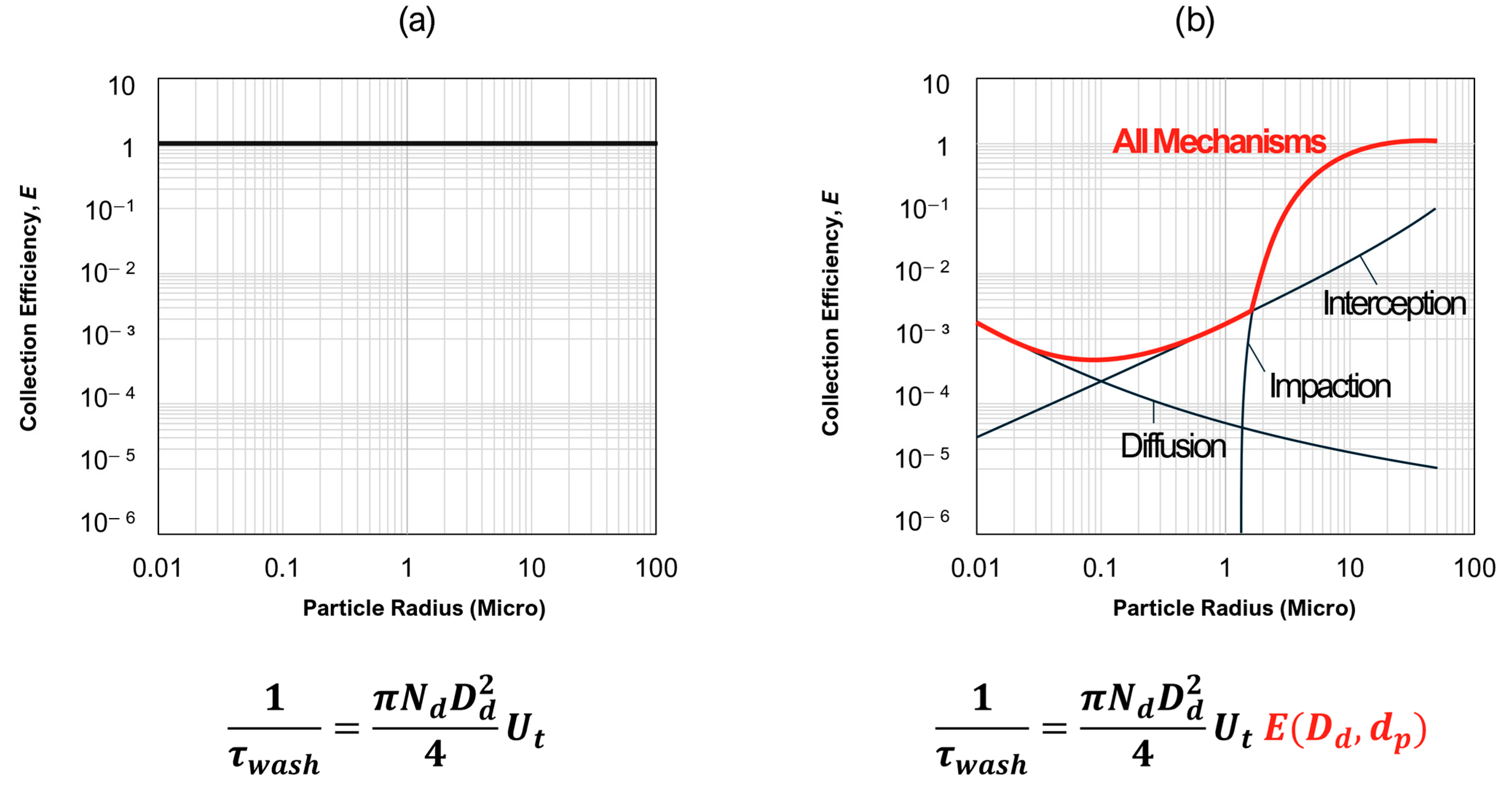
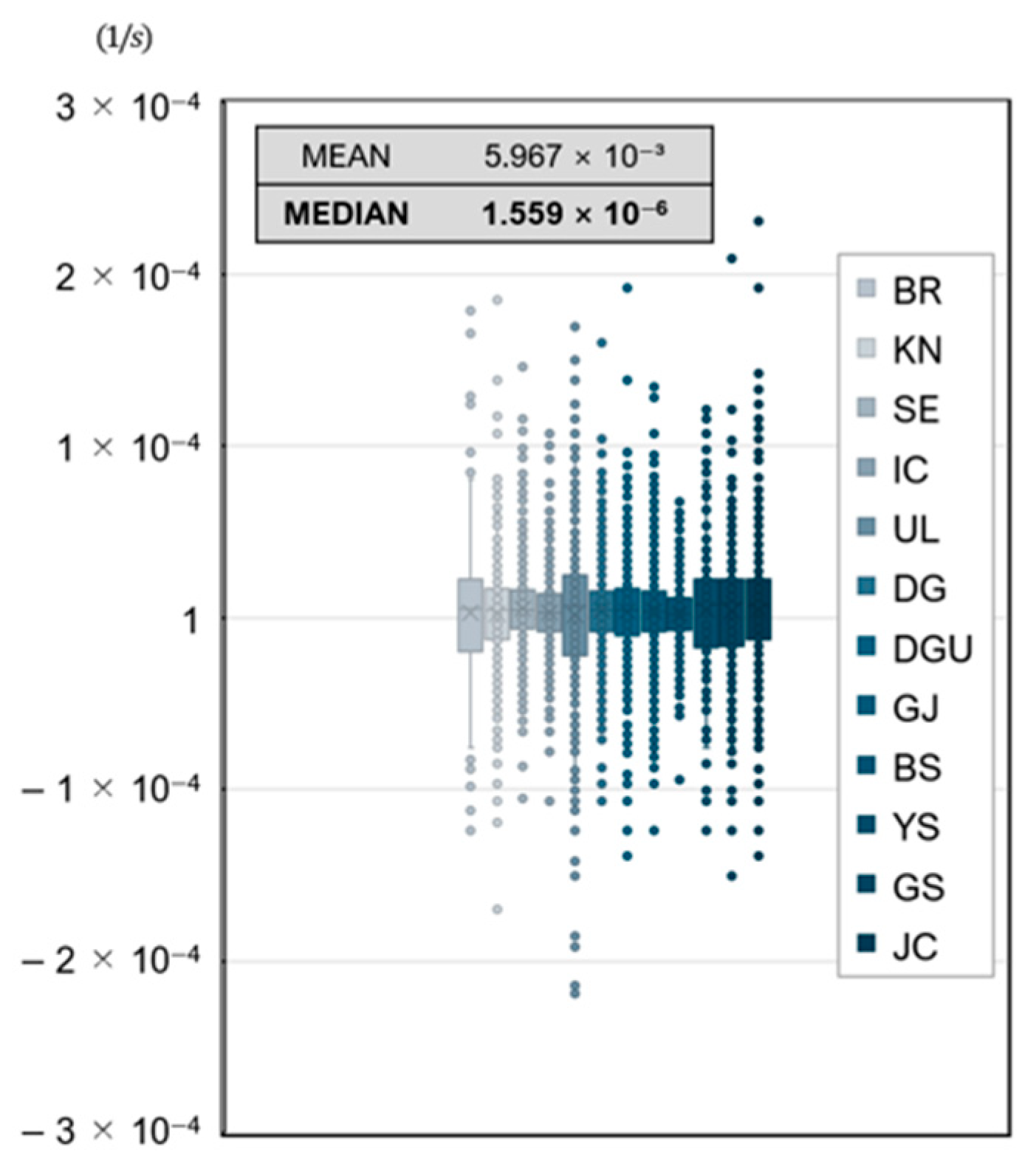
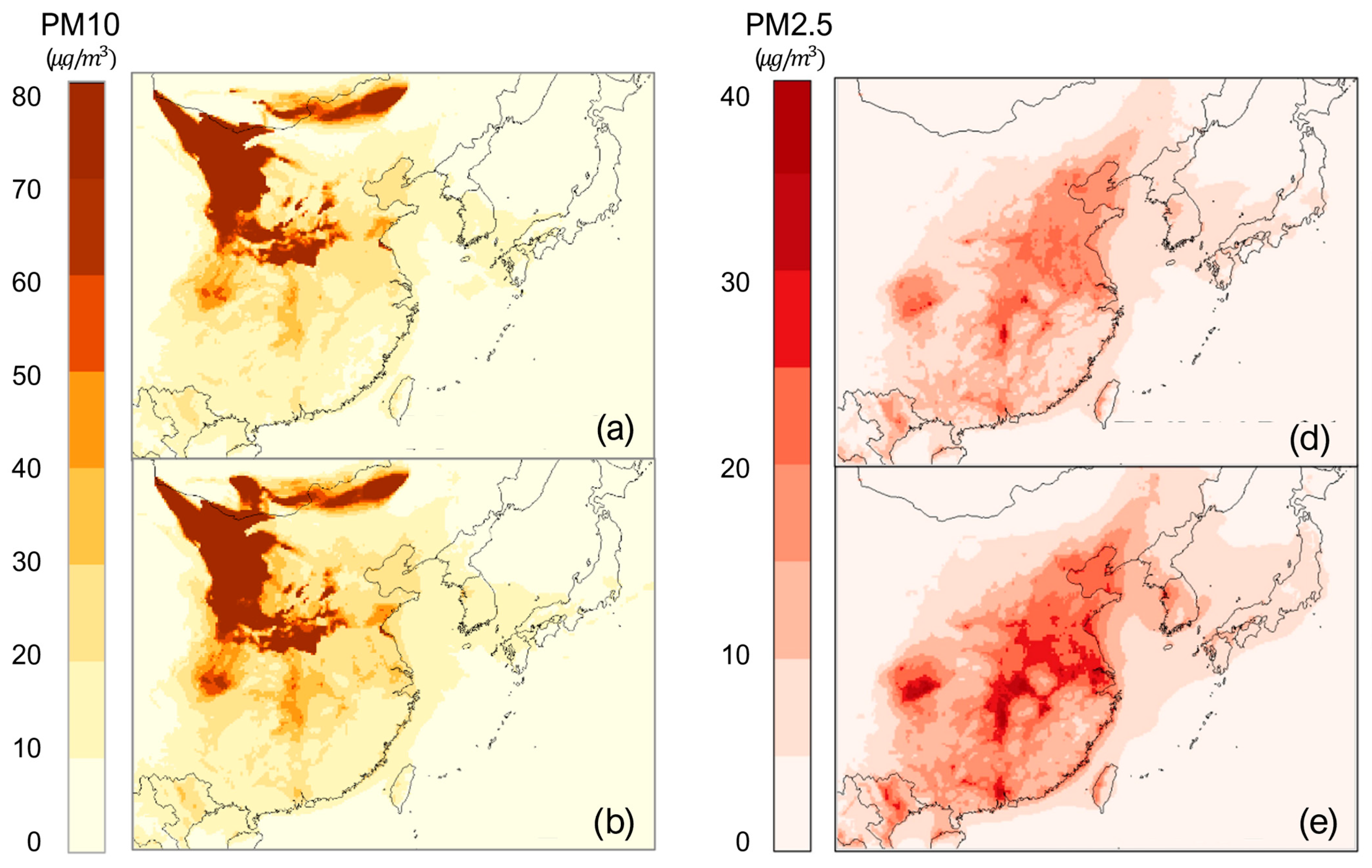
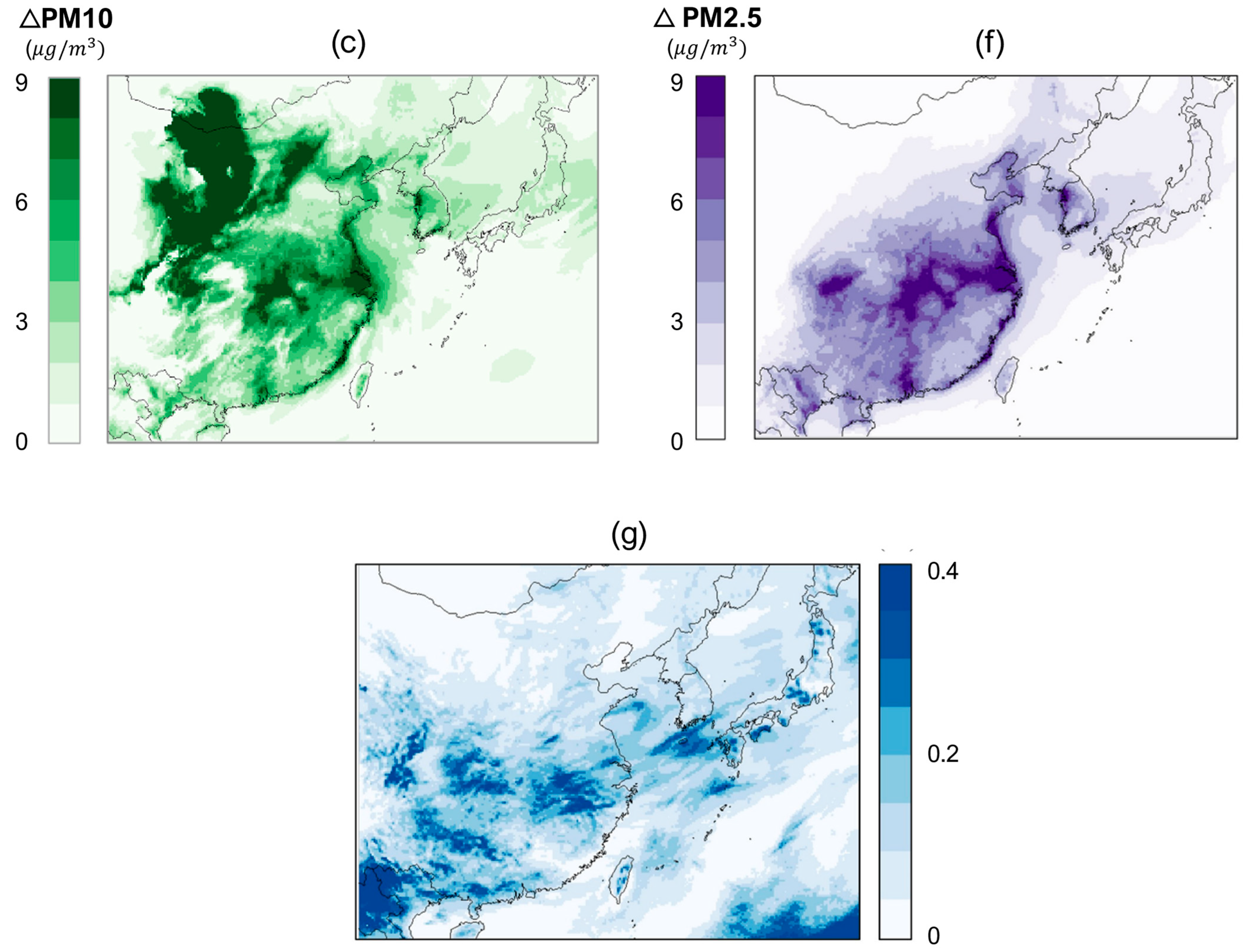






| Horizontal Grid | 273 (COLS) × 204 (ROWS) |
|---|---|
| Resolution | 15 km |
| Domain | 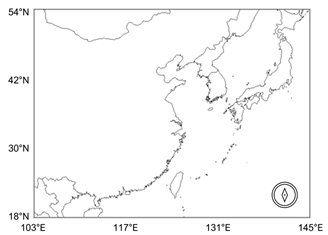 |
| Modeling period | Pre-running: 26 March∼1 April, 2018 (7 days) Main-running: 1 April∼30 April, 2018 (30 days) |
| CMAQ version | v5.1 |
| CMAQ chemical option | SARPC-07tc AERO6 (6th generation CMAQ aerosol module) |
| Simulation Name | Details |
|---|---|
| BASE | CMAQ default version |
| MOD | Modified wet deposition algorithms with new scavenging coefficients (Λ) of PM from this study |
| LITERATURE [43] | Modified wet deposition algorithms with Λ from [43] |
| GEOS | Modified wet deposition algorithms with Λ from Geos-chem measurements. |
| MB | MAGE | MNBE | RMSE | IOA | |
|---|---|---|---|---|---|
| BASE | −18.62 | 20.16 | −38.76 | 32.33 | 0.379 |
| MOD | −12.15 | 19.65 | −2.50 | 32.26 | 0.347 |
Disclaimer/Publisher’s Note: The statements, opinions and data contained in all publications are solely those of the individual author(s) and contributor(s) and not of MDPI and/or the editor(s). MDPI and/or the editor(s) disclaim responsibility for any injury to people or property resulting from any ideas, methods, instructions or products referred to in the content. |
© 2024 by the authors. Licensee MDPI, Basel, Switzerland. This article is an open access article distributed under the terms and conditions of the Creative Commons Attribution (CC BY) license (https://creativecommons.org/licenses/by/4.0/).
Share and Cite
Park, D.-S.; Choi, Y.; Sunwoo, Y.; Jung, C.H. Development of Wet Scavenging Process of Particles in Air Quality Modeling. Atmosphere 2024, 15, 1070. https://doi.org/10.3390/atmos15091070
Park D-S, Choi Y, Sunwoo Y, Jung CH. Development of Wet Scavenging Process of Particles in Air Quality Modeling. Atmosphere. 2024; 15(9):1070. https://doi.org/10.3390/atmos15091070
Chicago/Turabian StylePark, Da-Som, Yongjoo Choi, Young Sunwoo, and Chang Hoon Jung. 2024. "Development of Wet Scavenging Process of Particles in Air Quality Modeling" Atmosphere 15, no. 9: 1070. https://doi.org/10.3390/atmos15091070







